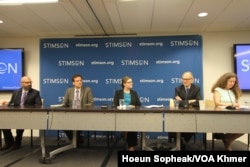From the snowy plateaus of Tibet to the mountain gorges of China’s Yunnan province and beyond to the jungled borders of Myanmar, Thailand, Laos and down to the plains of Cambodia and paddy fields of Vietnam – the Mekong River is of crucial importance to tens of millions of people.
Yet, the future of the mighty Mekong is far from certain.
Irrevocably change is underway upriver and downriver – from China to the Mekong delta – as countries along the river’s length pursue hydroelectric dams as a path to power generation.
Dams have already brought dramatic change to fishery communities, including Om Meng’s community in Patt Sanday commune in Cambodia’s Kompong Thom province.
“We experienced drought and that created a very difficult situation for us since the amount of fish in the lake is already reducing every year,” said Om Meng, explaining that dams on the upper reaches of the Mekong have already affected the flow of water in Cambodia’s Tonle Sap Lake.
“China built many big dams upstream, and we saw decreased numbers of fish. Plus, Laos is also building a dam in Don Sahong,” Om Meng, who is head of the local fishery community in his area, told VOA Khmer.
China has built six hydropower dams on the Mekong - known as the Lancang River to the Chinese. Laos is currently building two dams in Xayaburi and Don Sahong, and has plans for seven more, and it is estimated that scores of dams have been built or are planned on tributaries of the Mekong in Myanmar, Thailand, Cambodia and Vietnam.
Many have warned of the negative consequences of hydropower dams as they change the natural flow of rivers, alter sediment deposits, where fish swim, live and spawn, and even the temperature of water.
The reliance on hydropower is further complicated by climate change, and bouts of drought and flooding.
This year Vietnam saw severe drought and changes in river levels, which reached their lowest recorded levels in 100 years in the Mekong Delta. Many parts of Cambodia and Thailand were also hit by extreme heat and water shortages, leading China to open the gates of its Mekong dams to allow more water to flow to Mekong basin countries.
These changes are already so irrevocably that the state of the Mekong River cannot be reversed to how it was previously, said Dr. Milton Osborne, distinguished historian of Southeast Asia and Cambodia.
“It is absolutely essential, in my judgment, for the future of the people who live along the river that a recognition is given to the fact that you cannot change the river by building dams without having negative effects,” Dr. Osborne said.
Countries through which the Mekong flows know well that hydropower produces low cost electricity.
That is only part of the equation.
Hydropower projects cost hundreds of millions of dollars to build, and never seem to produce the output that was expected, said Jennifer Turner, director of the China Environment Forum at the Wilson Center.
“The fact is the current existing dams are not producing, and sometimes they are not producing half the amount of electricity that they are supposed to,” Turner said as part of a recent discussion in Washington on the impact of Mekong hydropower development.
The event was organized by the Stimson Center under the title: “Requiem for a River? Discussion on the Future of the Mekong.”
China’s roles in dam building on the Mekong, or Lancang, within its own borders, and as an investor in dam projects in down-river countries, was also a recurrent theme during the discussion.
Turner said that China currently depends on coal for more 60 percent of its energy consumption, and only 20 percent of its energy needs are derived from hydropower. As Turner told the discussion: Coal is king in China, and hydropower is queen.
In a bid to deal with air pollution, China has begun to shift its focus to renewable energy – solar and wind power – which may bode well for future Chinese investment in power generation in the Mekong region, she said.
“I think there is a bit of potential for a more diverse, cleaner and greener energy development by the Chinese investors in [the Mekong] region…it could be interesting to see that conversation moving forward,” Turner told VOA Khmer.
Richard Cronin, a research fellow and former director of the Southeast Asian program at the Stimson Center, said he was not hopeful that China would cease its own dam building projects or has any intention of encouraging lower Mekong countries to pursue renewable sources of energy.
“I think that what China is saying is it will address pollution for its own reasons and for its own interest,” he said.
Brian Eyler, deputy director of the Southeast Asian Program at the Stimson Center, and moderator of the discussion, and several others noted that Laos appeared to rethinking it previous hydropower development path, which was focused squarely on becoming the “battery of Southeast Asia.”
Courtney Weatherby, research associate for the Southeast Asia Program, Stimson Center, told the discussion that requests are now being received from Laos seeking assistance with ways to maximize dam efficiency.
There appears to be a “generational divide,” where younger Lao engineers are rethinking the costs of hydropower in terms of environmental and social consequences and not simply looking at the technology, as an older generation may have, in terms of hydropower as simply “plumbing” on a grand scale.
Dr. Cronin also seemed hopeful that the Lao government might be moving away from its earlier plans and institutional thinking about hydropower, but to do so would require strong engagement with China, and other large donor countries, such as the US and Japan.
“One of the things that I am hopeful about is that…it looks like Lao is not going to be able to have all those dams that it has planned, and that means it is time for Lao to rethink its development model, rethink its idea [about] becoming the ‘battery of Southeast Asia’,” he said.
For some experts, the possibility of a large country such as China, or smaller nations such as Lao, moving away from hydropower path is simply an illusion.
“I am not optimistic that the Chinese will stop building dams and that in doing so they will help to revive the Mekong,” Osborne wrote in an email to VOA Khmer.
“Neither do I see any sign that the Lao government will move away from its present policies,” he said.
Osborne described Vientiane’s policy of building dams on the Mekong as ‘the few endangering the many’ who need to river to survive.
“What the Lao government has chosen to do is to ignore the interests of the other people who live along the river and to pursue its own goals,” he said in an earlier interview with VOA.
The need for cheap energy usually outweighs all other concerns, said Mak Sithirith, a professor at the Department of Development Studies of the Royal University of Phnom Penh.
Mekong countries, including China, will continue to build the dams at a fast rate, as hydropower remains a key source of cheap energy, Mak Sithirith said.
“I don’t see that China would stop building dams and, plus, the lower Mekong countries including Cambodia and Lao are in dire need of cheap energy, and hydropower dams are very promising for their development,” he said.
Laos, he added, was in the best position to exploit hydropower compared to the other countries in the lower Mekong communities, and it will do so.
While expecting Mekong countries to move away from hydropower may be fanciful at present, some are urging for more engagement and cooperation between China and the lower Mekong countries through existing institutions, including the Mekong River Commission (MRC), the Lower Mekong Initiative, which is led by the US, and the Lancang Mekong Cooperation Mechanism, which is led by China.
Even if the three bodies engaged and cooperated more, the issue of “enforcement power” remains the main obstacle, participants at the Stimson-organized discussion said.
Without enforcement, there is nothing really stopping any one of the Mekong countries from pursuing policies that could be detrimental to others.
“The problem with all three of them is that none of them has this enforcement power,” said Jon Fasman, Southeast Asia bureau chief and acting Asia editor of The Economist whose recent essay “Requiem for a River,” inspired the discussion in Washington.
Many agree that the MRC is “a weak institution,” which requires serious reform to carry out its mandate to ensure sustainable development on the river.
“It is a weak organization, and yet it is an essential organization because it cannot be replaced,” the Stimson Center’s Dr. Cronin said.
“It could be improved, and it could become more effective. But that requires country themselves to get more serious about the organization,” he added.
Mak Sithirith, of the Royal University of Phnom Penh, also said the MRC needed jurisdictional power, particularly when it came to preventing dams being built where they could cause serious negative ecological and social damage.
“It’s unfortunate that the MRC’s agreement does not entitle the commission to hold jurisdiction to stop any country from building dams,” he said.
The Lao government is currently building the Don Sahong and Xayaburi dams on the Mekong, despite Cambodia and Vietnam continuing to object over fears of down-river impacts.
Besides the MRC, some hoped the US-led Lower Mekong Initiative would play a role in engaging the lower Mekong community and China through the Lancang Mekong Cooperation Mechanism.
That has not happened.
“The Lancang Mekong Commission is the place where the US could observe, and I think that there is opportunity for China to observe in the Lower Mekong Initiative. But so far we haven’t seen much in terms of hands shaking on that,” said Eyler of the Stimson Center.
The Lancang Mekong Cooperation Mechanism appears to be more about development money than the health of the river, Dr. Cronin said.
“China said to them [Mekong countries] under this Lancang Mekong Cooperation mechanism that –actually take our money, take our investment, take our loans. Integrate your economy and infrastructure with ours. Let’s not talk about the water,” he said.
What all the experts concerned about the Mekong did agree on: Leadership and political will is necessary if the future of this might river is to be assured.











